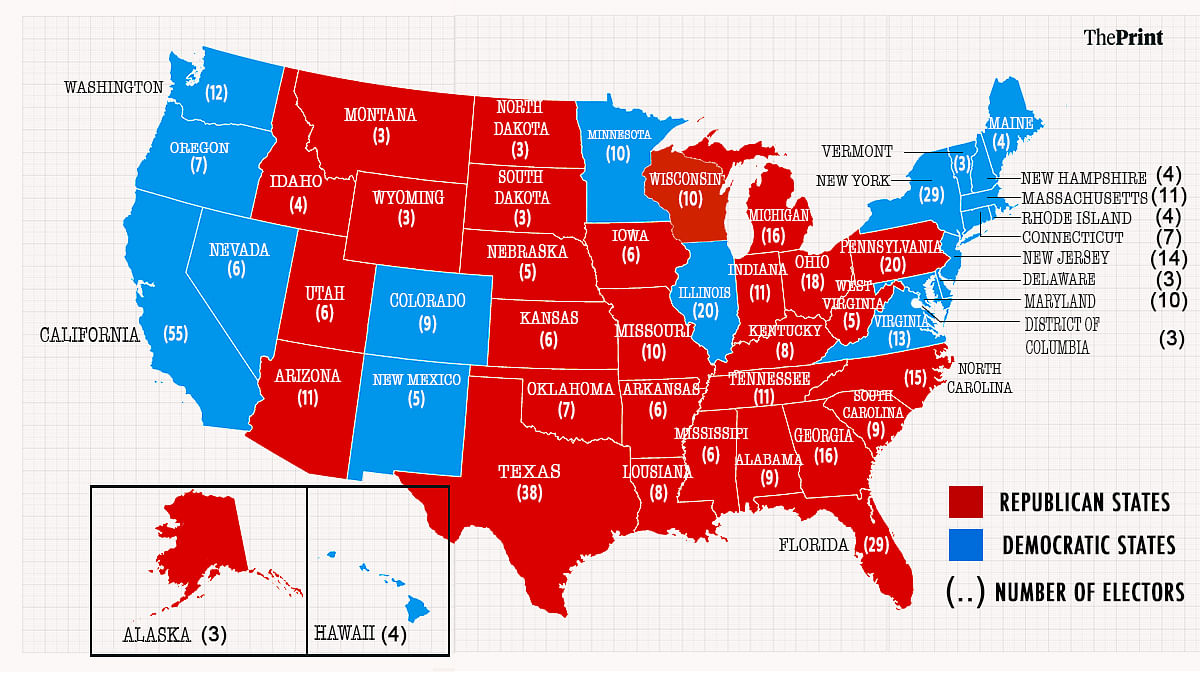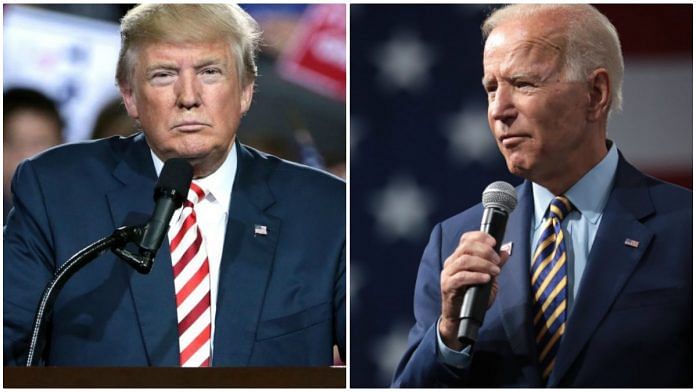New Delhi: The 2020 US presidential election is 40 days away, and opinion polls indicate the Democratic presidential nominee, Joe Biden, has roughly a seven-point lead over US President Donald Trump, the Republican candidate.
However, this statistic, which is based on an average of different opinion polls, only reflects the popular vote and not who will actually win the election that will take place on 3 November.
The US election works on a winner-takes-all principle, just like India’s elections. However, it doesn’t follow a strictly simple majority formula, i.e., the candidate with the most popular votes doesn’t necessarily win.
The crucial deciding factor in the process is the electoral college; the candidate with the most ‘electoral’ votes is elected US president.
In the past, five US presidents have won an election despite not cornering a majority of the popular vote. In fact, in the last election in 2016, Democratic presidential nominee Hillary Clinton received almost 3 million (30 lakh) more votes than Trump on Election Day, but lost in the electoral college.
As the campaign frenzy runs its final leg, here’s a look at how the US election process works, what the electoral college is and how it determines the election, and also how it varies from India’s first-past-the-post system despite both functioning on the same principle.
Also read: The world has changed too much for Biden to erase the Trump effect
How the US election process works
Before Americans get to the polling booth or vote by mail for their favourite presidential choice and their running mate (the vice-presidential candidate), parties elect their candidates (except incumbents) through one of two processes — primaries and caucuses. You can read more about these processes here.
Once the Republican and Democratic candidates are nominated, national conventions are held in which the running mates are announced. Joe Biden chose Kamala Harris, a politician of Indian-Jamaican descent, while Trump stuck with his current vice president, Mike Pence.
Following the conventions, the candidates go on tour to drum up public support as well as participate in several high-profile televised debates to shape public opinion.
With all this done, Americans finally make a choice on who they prefer as the president of the US for the next four years. However, this is still the penultimate stage in the process. The electoral college then votes, and the candidate with the majority becomes president.
Also read: It’s our economy, not her genes, that’ll influence Kamala Harris’ view of India
What is the electoral college
While citizens cast their ballot for a particular candidate, it is actually the ‘electors’ of the 50 states whose votes decide who becomes president. However, the trends from Election Day determine how electors vote.

Electors are part of a larger national body called the electoral college. They are chosen by the parties, though the process varies from state to state. In some cases, electors are simply appointed by the state party committee whereas in other cases, they campaign for the role and are voted in at state party conventions.
Electors vote for a candidate based on the popular vote in the state. For example, if more than half of the citizens in California cast their ballot in favour of Biden, all the state’s electors are bound to cast their vote for Biden.
“You only have to win a state by one vote to get a 100 per cent of its electors. The margin does not matter,” said Dr Mark J. Rozell, dean of the Schar School of Policy and Government of George Mason University in Virginia, at a virtual press briefing at the US Foreign Press Centers’ election tour Monday.
The exceptions to this are Maine and Nebraska which follow the Congressional District Method in which one electoral vote is tied to each congressional district in the state and a bonus two electoral votes are awarded to the candidate who secures the state-wide popular vote.
Electors gather in December to ratify the results of the election.
Also read: Biden’s $466 mn bankroll tops Trump by $141 mn — unprecedented financial edge for a challenger
How electoral votes stack up
There are currently 538 electors in the electoral college.
The number of electors for each state is the total of the number of representatives in the House of Representatives, the lower house, plus the two senators in the upper house. (The US has a bicameral legislature just like India does.)
For example, California has 53 representatives in the House and two senators, which gives it a total of 55 electoral votes.
To become president, a candidate needs to win a simple majority — 270 electoral votes. This is where the popular vote doesn’t necessarily help a candidate.
In 2016, Trump secured 306 electoral votes while Clinton secured only 232, thus becoming president even though Clinton won the popular vote by a wide margin.
Trump had won many more states by smaller margins, which meant he secured more electoral votes, explained Dr Rozell. For instance, Trump won Pennsylvania by 68,236 votes, Wisconsin by 27,257 and Michigan by 11,837 votes.
Similarly, George W. Bush won the 2000 election despite Al Gore winning the popular vote by almost half a million. However, that year, the presidency was decided by the Supreme Court; disputed votes in a Florida county ultimately gave Bush a razor-thin lead.
The larger the state, the more the number of representatives, and hence, more the number of electors. For instance, California has 55 and Texas 38, while North Dakota and Delaware have three each.
Also read: Why Democrats hold a secret edge if US presidential election is too close to call
How the system compares to India’s first-past-the-post system
When Indians vote in a general or state elections, they vote for an individual who will represent their constituency in Parliament or the state assembly. Unlike in the US, an Indian voter is choosing one out of several candidates on the ballot, each fielded by different parties. This is the first-past-the-post principle, also known as the ‘simple majority’ system.
In this system, a candidate doesn’t need to receive more than half of the votes in their constituency, but rather just more than their competitors.
For example, if a candidate secures 30 per cent of the votes in a constituency, which is the highest vote share, then they secure a seat in Parliament. Meanwhile, the remaining 70 per cent of the votes are rendered inconsequential since they got divided among the other competitors.
That is how the BJP, which secured just 37.6 per cent of the vote share in the 2019 general election, secured 303 seats out of 553 in Lok Sabha.
Also read: Making America comfortable again — Why Trump can win in November



